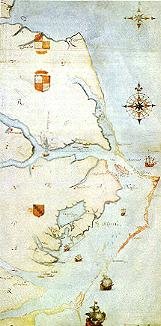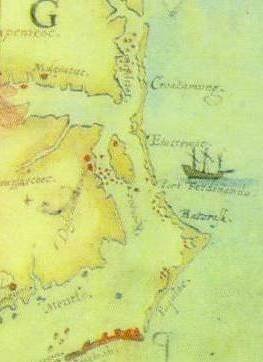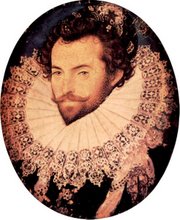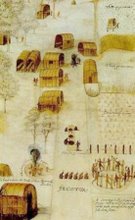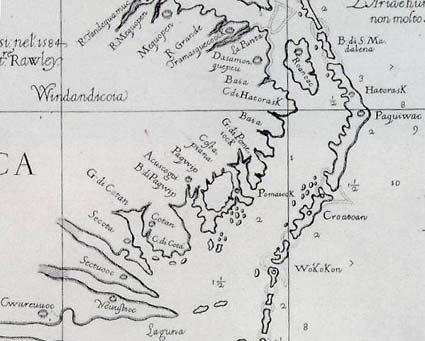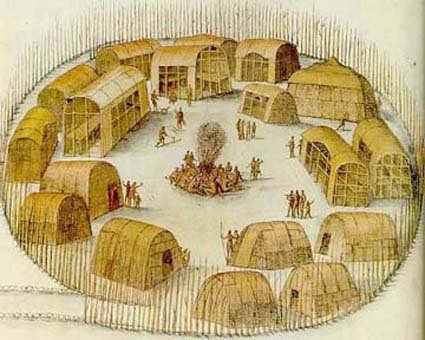Dust off the old VCR or your DVD recorder or Tivo. This is one you'll want to save! This week, the much-anticipated Time Team America begins its premiere season on PBS, five weeks over the summer during which public television viewers will get a first-hand look at high-tech archaeology in the United States. The first program, airing the evening of Wednesday July 8th (8 pm EDT, check local listings), features ongoing investigations at Fort Raleigh, North Carolina, the site of the first English colony in the American continents. The site is perhaps more famously known as the Lost Colony of Roanoke Island, and its legend about Virginia Dare, the first English child born in the Americas, and the mysterious disappearance of the colony has inspired untold numbers of American children into learning about the past. Time Team and Fort Raleigh Time Team America's hour long video on Fort Raleigh documents three days of excavations, assisted by geophysical survey. The test area is located at an area of the island that had been identified as containing historic artifacts of the right age about 10 years ago. Two large trenches are excavated over the three days in this area, opened using a backhoe to strip off the wind-blown sand believed to have been deposited on the area after the American Revolution. Backhoe stripping is a perfectly legitimate technique, which I suspect will surprise some viewers; its good and bad points aren't described here, but someday I might get to that.
JC
Kris's Archaeology Blog
Time Team America: Fort Raleigh
Monday July 6, 2009
Time Team America digging team leader Chelsea Rose and digging team member Jeff Brown carefully sift through the soil as they excavate at Fort Raleigh National Park on Roanoke Island. In addition to searching for artifacts, they are looking for subtle differences in soil texture that would indicate decayed wooden structures built by Roanoke’s legendary lost colonists. Photo by Crystal Street
Related:
http://the-lost-colony.blogspot.com/2009/07/why-time-team-went-to-roanoke.html
© History Chasers
Click here to view all recent Searching for the Lost Colony DNA Blog posts
Wednesday, July 8, 2009
PBS Time Team America premieres with Fort Raleigh July 8th
Posted by
Historical Melungeons
at
7/08/2009 08:36:00 PM
![]()
Labels: fort raleigh, lost colonists, Lost Colony DNA, PBS, Time Team America
Saturday, May 24, 2008
The Lost Colony Genealogy and DNA Research Group Website
This website is to display the results of our research in support of attaining our goal which is to discover, if possible, whether any of the Roanoke Lost Colonists survived. Furthermore, others included on Raleigh's numerous voyages were also "lost" on the shores of what would become North Carolina. Perhaps they survived as well. The resources being used to solve this mystery are a combination of historical records, genealogy and DNA.
Posted by
Historical Melungeons
at
5/24/2008 01:27:00 PM
![]()
Labels: fort raleigh, lost colonists, lost colony, Roanoke island
Thursday, May 22, 2008
New Dig on Roanoke Reveals Artifacts Previously Not Seen
Search ongoing for Lost Colony site
BY JESSICA BOWEN SENTINEL STAFF
Director of Native American Studies Program at University of Oklahoma, Joe Watkins, Ph.D., screens dirt for potential clues leading the the disappearance of America's early settlers. With his experienced eye he carefully examines for any sign of native American or European lifestyle.
Archaeological teams are geared up to answer the on-going mystery of Fort Raleigh's early settlers.Last week, First Colony Foundation (FCF) teamed up with scholars and the premier production of Time Team America to excavate grounds in hopes of finding artifacts that would answer any of the numerous questions surrounding the mystery. Fort Raleigh is the first of five sites for Time Team America's series and the team only had three days to complete the excavation. Thus, they worked from sun-up to sun-down, ensuring not a minute was wasted.
The team consists of archaeologists, geophysicists, sketch artists, and graphic artists along with the several in the production field. Lead digger Chelsea Rose explained the teams are "looking for artifacts or evidence of features of buildings" including post-holes relative to structures.To ensure no artifacts are being destroyed or overlooked, the diggers take extra care when sifting the soil. The first few layers, according to Rose, are from blown sand that came in as part of a dune, making it easy for the team to sift through. "We've got to get to the darker layers underneath if we're going to find anything," she noted.
After the soil has been removed, the team carefully sifts through each layer with screens. Ian MacDonald, with FCF, explained the soil goes through a large screen, then a smaller window screen, to guarantee no small pieces have been ignored. "We go as quickly as reasonable," noted MacDonald, "being very thorough in the process."If the team discovers an artifact, FCF Co-Director Nick Luccketti and archaeologist Eric Klingelhofer of FCF will analyze the findings to determine its authenticity.On the second day, the team found a very small piece of what is believed to be Native American pottery. "If you look real closely you can see pieces of shell, and you learn to recognize immediately," said Joe Watkins, Ph.D., Native American Archaeologist and a member of the Time Team. "I have a point of view different that others, I use the point of view of Native Americans."
As of press time, the teams had discovered several artifacts "both prehistoric and historic," said Klingelhofer. Along with the pottery found on their second day, two small sherds of English essex black ware was found on their third day. The black-ware is believed to have been used for cups and plates. According to Luccketti, the essex black-ware is unlike any artifact from previous excavations and seem to be connected with domestic use.
Full Article Here:
http://obsentinel.womacknewspapers.com/articles/2008/05/21/features/feats2251.txt
Posted by
Historical Melungeons
at
5/22/2008 08:44:00 AM
![]()
Labels: first colony foundation, fort raleigh, john white, lost colony, manteo, roanoke
Sunday, February 3, 2008
"The First Colony" Television Show's Last Broadcast Tonight
In a show produced by a local man, archaeologists say Spanish artifacts in western N.C. predate 'Lost Colony'
Click-2-Listen
By Ginger LivingstonThe Daily Reflector
Thursday, January 31, 2008
A public television show produced by a local man and airing tonight (repeats Sunday) features archeological work that could change how North Carolinians view the early history of the state.
"The First Lost Colony" is the segment airing locally at 8:30 p.m. on UNC-TV's "Exploring North Carolina" on Suddenlink channel 4. The show was co-produced and photographed by Pitt County resident Joe Albea.
Archaeologists studying the site of a 16th century Spanish fort in Burke County have found pottery shards from olive jars, finishing nails and lead balls used in muskets.
"The First Lost Colony" examines the work archeologists from North Carolina, South Carolina and Illinois are doing at a Burke County farm. Scientists are certain it is the location of Fort San Juan, one of five colonies the Spanish established in the interior United States about 20 years before the British sent its failed colony to Roanoke Island in what is now Dare County. That group of men and women became the storied "Lost Colony" that vanished, leaving only the word "Croatoan" carved on a tree.
"The 16th century for the large part is forgotten but there was a lot of exploration of the continent at that time," Albea said.
The N.C. Natural History Museum hosted a premiere of the show Wednesday night in Raleigh. About 250 attended the event, including the site's discoverer, Warren Wilson College professor and archeologist David Moore, and his colleagues Robin Beck with Southern Illinois University and Christopher Rodning with the University of North Carolina at Chapel Hill.
http://www.archaeologynews.org/story.asp?ID=259706&Title=In%20a%20show%20produced%20by%20a%20local%20man,%20archaeologists%20say%20Spanish%20...
To read more about the work at the Berry site, visit http://www.warren-wilson.edu/~storyteller/NEWS/NEWS-jbowers-2006-9-14-11-2-53.shtml
Read more:
http://www.worldsedge.net/desoto/BECK_FROM%20JOARA%20TO%20CHIAHA.htm
http://64.233.167.104/search?q=cache:GLvXxydhHfYJ:www.ncmuseumofhistory.org/collateral/articles/F05.first.people.pdf+de+soto+fort+burke+county&hl=en&ct=clnk&cd=4&gl=us
Posted by
Historical Melungeons
at
2/03/2008 01:55:00 PM
![]()
Labels: burke county, Croatoans, de Soto, fort raleigh, indian, lost colony, north carolina, pitt colony, roanoke, santa elena
Tuesday, January 29, 2008
Lost Colony Dig; Probing the Past with Radar
BY ED BECKLEY | SENTINEL CORRESPONDENT
When doctors want to see a body's organs they use an magnetic resonance imaging machine (MRI) to view beautifully clear images of what's inside.
When archaeologists want to see what's below the surface of the earth they are now beginning to use a similar technology called computer-assisted radar tomography (CART).
An archaeologist with the First Colony Foundation was on site at Fort Raleigh Saturday with CART engineers testing the advanced ground penetrating system. Their hope is that CART will prove to be a viable tool to help find artifacts from Sir Walter Raleigh's 16th Century colonies in the future.
The First Colony Foundation comprises a team of top archaeologists who in recent years discovered the expanded Jamestown, Va. settlement. The group also is a partner with the National Park Service in search of the Elizabethan presence on Roanoke Island. It has dug its share of holes along Roanoke Sound the past couple of years.
http://obsentinel.womacknewspapers.com/articles/2008/01/23/top_stories/tops3441.txt
Posted by
Historical Melungeons
at
1/29/2008 09:09:00 PM
![]()
Labels: advanced ground penetrating system, CART, fort raleigh, lost colony, radar tomography, Roanoke island
Monday, January 28, 2008
Search for Lost Colony takes a high-tech turn
By Catherine Kozak
The Virginian-Pilot©
January 28, 2008
An innocuous-looking golf course tractor pushing a platform on wheels could help illustrate the nation's oldest mystery.
In the quest for the Lost Colony, the vanished 1587 English settlement on Roanoke Island, archaeologists have conducted numerous explorations in Fort Raleigh National Historic Site, digging and surveying and scanning and scoping.
But they've never used high-tech radar tomography that can produce 3-D images out of data collected from 6 feet, more or less, under ground.
The refined technology, which can also use sound and light waves, gained early fame when inventor Alan Witten used it to help locate fossils from a 120-foot-long dinosaur - called "seismosaur us " - in the late 1980s in New Mexico. The find was fictionalized in Michael Crichton's "Jurassic Park."
"This is fantastic, cutting-edge technology," said Eric Klingelhofer, vice president of the First Colony Foundation, in a telephone interview. "I am eager to see the findings and then compare them with what we know of the archaeology of the site."
On a recent, rainy Saturday morning, Klingelhofer, who is a professor at Mercer University in Georgia, watched as a contractor with Witten Technologies drove the tractor back and forth in the parking lot and grass borders near the ticket booth at Waterside Theatre, where "The Lost Colony" outdoor drama is performed each summer.
"We're picking up the utilities, which is good, because that's what the equipment is designed to do," he said. "But we have picked up some anomalies, which is good."
The veteran archaeologist said the foundation, which has an agreement with the National Park Service to do archaeological investigations at the park, dug on the sound side of the parking lot in 2006. And in the 1990s, archaeologists dug between the earthworks and the theater. The hope, he said, is that Witten's technology, which is costing a couple of thousand dollars, can help pinpoint where significant anomalies, or irregularities, are located before the archaeologists touch a shovel.
http://hamptonroads.com/2008/01/search-lost-colony-takes-hightech-turn
Posted by
Historical Melungeons
at
1/28/2008 11:01:00 PM
![]()
Labels: Archaeology, fort raleigh, lost colony, north carolina, radar tomography, roanoke



